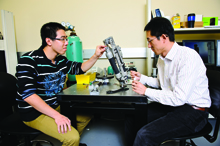Xiangrong Shen, PhD, an assistant professor of mechanical engineering at The University of Alabama (UA), Tuscaloosa, has launched a four-year project with researchers from UA; Vanderbilt University, Nashville, Tennessee; and the Georgia Institute of Technology (Georgia Tech), Atlanta, to produce an alternative transtibial prosthesis that is capable of actively powering the ankle joint in use. He recently received a $564,000 grant from the Eunice Kennedy Shriver National Institute of Child Health and Human Development to help fund the project, and is currently working on a prototype.

Shen (on the right) discusses a prototype of a transtibial prosthesis with graduate student Molei Wu.
Photograph courtesy of The University of Alabama.
According to Shen, there are two key components in the new prosthesis. The first is a liquid fuel called monopropellant, which works as an energy-storing medium and decomposes upon contact with certain catalysts. The use of this fuel allows for a lightweight prosthesis that stores enough energy to operate for daily use. The second component is a sleeve muscle actuator, an artificial muscle that replaces the motor used in some alternative prostheses as the prosthetic actuator. The sleeve muscle is more powerful, with a lighter weight and more compact profile, and its elastic properties are similar to a biological skeletal muscle.
Shen has successfully demonstrated the basic concept of the actuator and how to use it to drive a robotic joint.
“This is a relatively new system,” Shen said. “There are some problems in putting the prosthesis into clinical use because the components of the prosthesis are still being developed. In our research, the long-term goal is to develop powered prostheses with comparable appearance and functionality as human limbs.”
To better guarantee the safety and reliability of the prosthesis, Shen plans to explore new approaches in fuel storage, exhaust management, thermal insulation, and heat management.
After the research element of the project is completed, Shen and his team will test the device at Georgia Tech where he will use their multicamera motion capturing system to measure his subject’s gait. He will also use a force plate to assess the kinetics in walking as well.
Editor’s note: This story has been adapted from materials provided by The University of Alabama.




